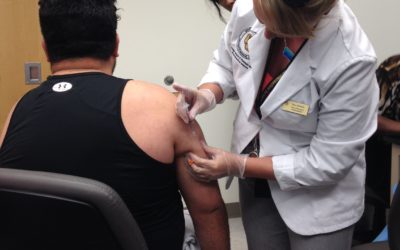Sunscreen
When I moved to Denver about 7 years ago, it surprised me that the sun was SO MUCH more intense than back in the mountains of East Tennessee. It’s around 93 million miles from the earth to the sun, and I didn’t think being just a bit closer in the mile high city would make much of a difference. What does make the big difference is that there is one mile less atmosphere protecting Denverites from the rays of the sun.
The sun provides an abundance of radiation; we can see radiation that corresponds to colors, but there is also radiation that is infrared and ultraviolet, above or below the visible wavelengths of sunlight. Folks mostly worry about the sun during the longer summer days when we have more sunlight, but our Colorado skiers know that you can sunburn during the winter as well. Of course, our winter skiers are usually protected by significantly more clothing than our summer funseekers.
Ultraviolet radiation affects our skin in different ways, and is described as three wavelength regions: A, B and C.
The atmospheric ozone layer absorbs UV-C radiation, so UV-C is a concern beneath the ozone hole in Patagonia, but not in the United States. UV-B radiation is associated with sunburn; think of the B as standing for “burn”. UV-A radiation produces long-term changes in the skin associated with aging; think of the A as standing for “aging”.
In addition to different types of sun rays, there are also different skin types.
Blue-eyed, redheads with lots of freckles tend to always burn very readily and may never tan. My grandson has this skin type. Very dark-skinned people may never burn no matter how much sun exposure they get. Others will be more or less likely to sunburn depending on their individual skin color. Patients usually know how likely they are to tan or burn, although I have encountered darker-skinned patients who were surprised when their skin started hurting after a long day in the sun.
The immediate concern with sun exposure has been and remains sunburn.
My red-hair blue-eyes grandson could sunburn in as little as 5 minutes on a high intensity day in Denver. Most adults will have an idea how long they can get away with during a bright summer day. Kids don’t, and are more likely to get sunburned. But sunburn is only the immediate, visible and painful reminder of too much UV-B sun exposure.
UV-A radiation is also present and is responsible for tanning and the long-term skin damage associated with aging.
Sun exposure accelerates aging in all skin types and all skin colors. Fortunately it is possible to protect our skin from long-term sun damage. Ingredients that shield the skin from UV-A radiation include: avobenzone, mexoryl, titanium dioxide and zinc oxide.
Pharmacists are often asked to recommend sunscreen products, and there are different ways of deciding what might be the best strategy for you. To be honest, I don’t actually like putting sunscreen on; I prefer to minimize my time in the sun, stay in the shade and wear clothing that keeps the sun off my skin. I like to bike in the early morning or in the evening when I don’t have to worry about sun protection.
Unless you are a vampire, though, you’ll find yourself in the sun sometime.
Pharmacists tend to look at the ingredients in sunscreen products. I think of sunscreens as containing either chemical sunscreens or physical sun blockers, and as protecting only against sunburn (UV-B only), or providing full spectrum protection against both UV-A and UV-B.
Chemical sunscreens contain complex chemicals that absorb solar radiation, but sometimes irritate the skin. Physical sunscreens contain inert ingredients – titanium dioxide and/or zinc oxide – that block UV-A and UV-B well, but some products can make your skin look pale. Those with sensitive skin may find that the physical sunblocks will work best for them.
Choose a sun protection product that you will USE.
Those who sunburn should at a minimum use a UV-B sunscreen. The SPF – sun protection factor – should be at least 15, and preferably 30 or higher. We all age in the sun, and the full spectrum UV-B and UV-A products protect against deeper long-term skin damage. Apply and reapply sunscreen liberally according to the directions on the bottle.
It’s OK to combine sunscreens. When I bike during the day, I like the convenience of a continuous spray broad spectrum SPF 50 sunscreen for my legs, but use a physical sunblock lotion for more sensitive areas: arms, neck and face.
There is no such thing as a safe tan.
Both sun exposure and tanning booths produce long-term skin damage. If you need to look tanned, the spray-on tanning process is safer than being in the sun. But remember that artificial tanning does not protect your skin from the sun; you will still need to use sun protection.
Take good care of yourself. Sun protection pays off with decreased risk of skin cancers and younger-looking skin in the long run. And it won’t take long for looking younger to look good on you.
Other Resources:
1. http://www.cdc.gov/cancer/skin/basic_info/sun-safety.htm
2. http://www.nlm.nih.gov/medlineplus/ency/patientinstructions/000378.htm












